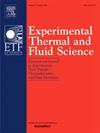Experimental investigation of unsteady fan-intake interactions using time-resolved stereoscopic particle image velocimetry
IF 2.8
2区 工程技术
Q2 ENGINEERING, MECHANICAL
Experimental Thermal and Fluid Science
Pub Date : 2025-03-24
DOI:10.1016/j.expthermflusci.2025.111482
引用次数: 0
Abstract
Understanding engine response to unsteady intake flow distortion is a crucial requirement to de-risk the development of novel aircraft configurations. This is more critical for configurations with highly embedded engines. Recent advances in non-intrusive, laser-based flow diagnostics demonstrated the ability to measure unsteady flows in convoluted intakes with high resolution in time and space. This work presents novel non-intrusive, unsteady flow measurements ahead of a fan rotor coupled to a convoluted diffusive intake. The fan rotor caused a local increase of the maximum levels of swirl intensity at the blade tip region, as well as flow re-distribution at the interface plane between the fan and the inlet duct compared to the baseline configuration with no fan in place. This contributed to the reduction of the overall swirl angle unsteadiness across the main flow distortion frequencies. This research presents a notable advance in unsteady fan-intake interaction characterisation. The work shows that high-resolution optical measurements offer notably better understanding of these complex aerodynamic interactions and have the potential to be part of larger scale, industrial testing programmes for future product development and certification.
非定常风扇-进气相互作用的时间分辨立体粒子图像测速实验研究
了解发动机对不稳定进气流变形的响应是降低新型飞机构型开发风险的关键要求。这对于高度嵌入式发动机的配置来说更为重要。基于激光的非侵入式流量诊断技术的最新进展表明,该技术能够以较高的时间和空间分辨率测量迂回进气道中的非稳态流量。这项工作展示了一种新型的非侵入式非稳态流动测量方法,该测量方法可在风扇转子与迂回扩散式进气口耦合的前方进行。与未安装风扇的基线配置相比,风扇转子导致叶片尖端区域漩涡强度最大值的局部增加,以及风扇与进气管道之间界面平面的流动重新分布。这有助于降低主要流动畸变频率下的整体漩涡角不稳定性。这项研究在非稳态风机与进气管相互作用表征方面取得了显著进展。研究结果表明,高分辨率光学测量可以更好地了解这些复杂的空气动力相互作用,并有可能成为未来产品开发和认证的更大规模工业测试项目的一部分。
本文章由计算机程序翻译,如有差异,请以英文原文为准。
求助全文
约1分钟内获得全文
求助全文
来源期刊

Experimental Thermal and Fluid Science
工程技术-工程:机械
CiteScore
6.70
自引率
3.10%
发文量
159
审稿时长
34 days
期刊介绍:
Experimental Thermal and Fluid Science provides a forum for research emphasizing experimental work that enhances fundamental understanding of heat transfer, thermodynamics, and fluid mechanics. In addition to the principal areas of research, the journal covers research results in related fields, including combined heat and mass transfer, flows with phase transition, micro- and nano-scale systems, multiphase flow, combustion, radiative transfer, porous media, cryogenics, turbulence, and novel experimental techniques.
 求助内容:
求助内容: 应助结果提醒方式:
应助结果提醒方式:


